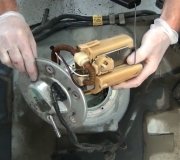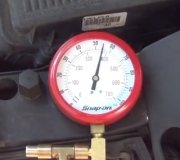Welcome back:
If you take a look at the attached picture (1), it indicates the engines in which I have information. Next, all of the engines listed have an O2 sensor. It is behind the catalytic converter. Take a look at picture 2. It shows location. Note that it says 4wd only. That is only for the shield and not the location of the sensor.
Here are directions for fuel injection. The specs are included and the remaining pics correlate with the directions.
____________________________________
FUEL PRESSURE TEST
FUEL PUMP QUICK CHECK:
1. Check that battery voltage is at least 12 volts.
2. Turn on the ignition switch.
3. Using a service wire, short terminals +B and FP on the engine check connector. The fuel pump should operate.
Shorting Fuel Pump Test Terminals
pic 3
4. Feel the fuel hose coming from the fuel filter to the fuel rail. The fuel flow should be felt, if the fuel pump is operating.
Checking For Fuel Pump Operation
pic 4
5. If not, perform pressure test below.
6. If fuel flow is felt, fuel pump operation is indicated, although fuel pressure may not be correct. For an accurate diagnosis, perform pressure test.
FUEL PRESSURE TEST:
1. Check that battery voltage is at least 12 volts.
2. Disconnect battery negative terminal.
3. Remove fuel delivery pipe between Cold Start Injector and fuel rail. Use caution if the fuel system is still under pressure.
Disconnecting Cold Start Injector Fuel Pipe
pic 5
4. Connect a suitable fuel pressure gauge to the fuel rail using the union bolt and gaskets to provide a tight seal.
Connecting Fuel Pressure Gauge
pic 6
5. Wipe off any gasoline that may have escaped when the fuel pipe was disconnected and reconnect negative battery terminal. Turn on the ignition switch.
6. Using a service wire, short terminals +B and FP on the engine check connector. The fuel pump should operate and cause the pressure gauge to deflect.
Shorting Fuel Pump Test Terminals
pic 7
Fuel Pressure: 38 - 44 PSI (265 - 304 kPa)
7. If pressure is low, check fuel pump output and/or fuel filter for restrictions. If pressure is high, refer to FUEL PRESSURE REGULATOR/FUEL RAIL and test components.
8. If there is zero fuel pressure, check fusible links, fuses (EFI 15A, IGN 7.5A), EFI Main Relay and circuit wiring. Refer to CHASSIS ELECTRICAL DIAGRAMS for circuit schematics.
9. If no problem is found with the above components, go to the gas tank and listen for sound from the electric fuel pump.
10. If sound is heard, confirm that there is fuel in the tank.
11. If no sound is heard, remove the fuel pump from the tank, (refer to COMPONENT REPLACEMENT AND REPAIR PROCEDURES), and bench test the fuel pump with battery current.
12. If fuel pump does not operate, replace the fuel pump.
13. After repairs are made, remove all test equipment from engine, start engine and check for fuel leaks.
__________________________________
Let me know if that helps.
Joe
Images (Click to make bigger)
Tuesday, April 30th, 2019 AT 6:42 PM

















